Assessment of Sustainable Development of Rural Settlements in Mountainous Areas: A Case Study of the Miaoling Mountains in Southwestern China
Abstract
:1. Introduction
2. Data Collection and Methods
2.1. Study Area
2.2. Data Collection
2.3. Construction of Evaluation Index System
2.3.1. Index System Construction
2.3.2. Methods
- (1)
- Geographical detector method
- (2)
- RS-SDI
- (3)
- Bivariate Local Moran’s I
2.4. Research Principles and Processes
3. Results
3.1. Hierarchical Characteristics and Spatial Patterns of the RS-SDI in the Miaoling Mountains
3.2. Sustainable Development Levels of the Rural Settlements in the Miaoling Mountains under Different Influencing Factors
3.2.1. Influences of the Natural Environmental Factors on the Level of Sustainable Development of the Rural Settlements
3.2.2. Socio-Economic Influences on the Level of Sustainable Development of Rural Settlements
4. Discussion
4.1. Classification of Rural Sustainable Development Level Typologies Based on Local Autocorrelation
- (1)
- Agricultural resource-based type
- (2)
- Urban-rural integration-based type
- (3)
- Industrial development-based type
4.2. Strategies for Optimising the Sustainable Level of Rural Settlements
4.3. A Comparative Study of the Factors Influencing Sustainable Rural Development
- (1)
- Natural constraints, mainly in terms of topography, soil quality, and effective use of resources, are important reasons for the low level of sustainable development in mountainous villages.
- (2)
- Social factors related to transport, agricultural practices, and the backward or deformed development patterns of rural areas due to the blind pursuit of economic profit further limit their sustainable development. At the same time, there are certain similarities in the policies adopted by each region to address the sustainable development of rural areas.
- (3)
- Top-down policy guidance has provided direction for sustainable rural development and facilitated the transition to sustainable development.
- (4)
- Bottom-up community involvement further contributes to the transition to sustainable development in each region, as in the case of soil and water conservation initiatives initiated by the inhabitants of the Andean countryside.
4.4. Limitations and Prospect
5. Conclusions
- (1)
- The sustainable development level of the rural settlements in the Miaoling Mountains is generally at the lower end of the medium level. There is apparent spatial heterogeneity among villages with different levels of sustainable development, with the high sustainable development settlements tending to be distributed around urban areas while the low sustainable development settlements are scattered.
- (2)
- The bivariate spatial autocorrelation analysis between each influencing factor and the level of sustainable rural development revealed that the GDP, arable land area, elevation, NDVI, water system, and roads all exhibited positive spatial correlation, while the slope exhibited a negative spatial correlation. In the local autocorrelation analysis, the bivariate local autocorrelation of RS-SDI with each factor exhibited certain characteristics. However, in general, there was a certain spatial similarity, with the HH and LL type settlements primarily located in the form of clusters. The HH type settlements were mainly concentrated in the north-western part of the Miaoling Mountains in the towns and villages around the cities with sound economic development and obvious socio-economic advantages. In contrast, the LL type settlements were concentrated in the south-eastern and central parts of the Miaoling Mountains in the hills and the slopes of gullies. The LH and HL type settlements were sporadically distributed, and the development trend of the intensification and aggregation was not noticeable.
- (3)
- Based on the local spatial autocorrelation analysis results, the rural settlements were classified into three categories, i.e., agricultural resource-based, urban-rural integration-based, and industrial development-based settlements, and optimised, sustainable development strategies were developed for each of these three categories.
Author Contributions
Funding
Institutional Review Board Statement
Informed Consent Statement
Data Availability Statement
Conflicts of Interest
References
- Brundtland, G.H. What is sustainable development. In Our Common Future; Oxford University Press: New York, NY, USA, 1987; Volume 8. [Google Scholar]
- Anand, S.; Sen, A. Human development and economic sustainability. World Dev. 2000, 28, 2029–2049. [Google Scholar] [CrossRef]
- Islam, R.M.; Barr, E.; Gregg, E.W.; Pavkov, M.E.; Harding, J.L.; Tabesh, M.; Koye, D.N.; Shaw, J.E. Trends in incidence of total or type 2 diabetes: Systematic review. BMJ Clin. Res. 2019, 366, 1. [Google Scholar]
- Bogale, A.; Shimelis, A. Household level determinants of food insecurity in rural areas of Dire Dawa, Eastern Ethiopia. AJFAND 2009, 9, 3. [Google Scholar] [CrossRef]
- Qayyum, W.; Siddiqui, R. Causes of youth unemployment in Pakistan [with comments]. In PDR; Pakistan Institute of Development Economics: Islamabad, Pakistan, 2007; pp. 611–621. [Google Scholar]
- Mboumboue, E.; Njomo, D. Potential contribution of renewables to the improvement of living conditions of poor rural households in developing countries: Cameroon’s case study. Renew. Sustain. Energy Rev. 2016, 61, 266–279. [Google Scholar] [CrossRef]
- Boggia, A.; Rocchi, L.; Paolotti, L.; Musotti, F.; Greco, S. Assessing Rural Sustainable Development potentialities using a Dominance-based Rough Set Approach. J. Environ. Manag. 2014, 144, 160–167. [Google Scholar] [CrossRef]
- Awojobi, O.N. Sustainable rural development in Nigeria within the context of the Millennium Development Goals. Int. J. Contemp. Appl. Sci. 2014, 1, 58–74. [Google Scholar]
- Rahman, K.M.; Edwards, D.J.; Melville, L.; El-Gohary, H. Implementation of bioenergy systems towards achieving United Nations’ sustainable development goals in rural Bangladesh. Sustainability 2019, 11, 3814. [Google Scholar] [CrossRef]
- Pasanchay, K.; Schott, C. Community-based tourism homestays’ capacity to advance the Sustainable Development Goals: A holistic sustainable livelihood perspective. Tour. Manag. Perspect. 2021, 37, 100784. [Google Scholar] [CrossRef]
- Padda, I.U.H.; Hameed, A. Estimating multidimensional poverty levels in rural Pakistan: A contribution to sustainable development policies. J. Clean. Prod. 2018, 197, 435–442. [Google Scholar] [CrossRef]
- Bebbington, A.; Browder, J.O. Fragile lands of latin america: Strategies for sustainable development. Lat. Am. Anthr. Rev. 2010, 2, 23. [Google Scholar] [CrossRef]
- Toledo, Á.; Burlingame, B. Biodiversity and nutrition: A common path toward global food security and sustainable development. J. Food Compost. Anal. 2006, 19, 477–483. [Google Scholar] [CrossRef]
- Tumushabe, J.T. Climate change, food security and sustainable development in Africa. In The Palgrave Handbook of African Politics, Governance and Development; Palgrave Macmillan: New York, NY, USA, 2018; pp. 853–868. [Google Scholar]
- Salvati, L.; Zitti, M. Assessing the Impact of Ecological and Economic Factors on Land Degradation Vulnerability through Multiway Analysis. Ecol. Indic. 2009, 9, 357–363. [Google Scholar] [CrossRef]
- Nourry, M. Measuring sustainable development: Some empirical evidence for France from eight alternative indicators. Ecol. Econ. 2008, 67, 441–456. [Google Scholar] [CrossRef]
- Phillis, Y.A.; Kouikoglou, V.S.; Verdugo, C. Urban sustainability assessment and ranking of cities. Computers. Comput. Environ. Urban Syst. 2017, 64, 254–265. [Google Scholar] [CrossRef]
- Liu, Y.S. Research on the urban-rural integration and rural revitalization in the new era in China. Acta Geogr. Sin. 2018, 73, 637–650. [Google Scholar]
- Rahman, K.M.; Edwards, D.J.; Melville, L.; El-Gohary, H. The Research Progress on Typical Areas in China. Prog. Phys. Geogr. 2011, 30, 1538–1547. [Google Scholar]
- Sun, Y.; Cheng, Y.Q.; Zhang, P.Y. Spatio-temporal dynamics of rurality in Northeast China. Geogr. Res. 2015, 34, 1864–1874. [Google Scholar]
- Cao, Z.; Liu, Y.S.; Li, Y.R.; Wang, Y.S. Spatial pattern and its influencing factors of specialized villages and towns in China. Acta Geogr. Sin. 2020, 75, 1647–1666. [Google Scholar]
- Gao, H.J.; Han, H.Q.; Lu, X.Q. Effects of Roads on Rural Settlement Landscape Pattern in Mountain Areas of Southwest China. Areal Res. Dev. 2016, 35, 139–143. [Google Scholar]
- Tu, S.S.; Long, H.L.; Zhang, Y.N.; Zhou, X. Process and driving factors of rural restructuring in typical villages. Acta Geogr. Sin. 2019, 74, 323–339. [Google Scholar]
- Dong, Y.; Cao, X.J.; Cheng, K.; Tai, T.S.; Hu, X.Q.; Wang, L.L.; Li, Z.H. Eatures of the geological remains of Miaoling National Geopark, Qiandongnan, Guizhou. Chin. J. Geol. Hazard. Ctrl 2010, 21, 129–132. [Google Scholar]
- Khoshnava, S.M.; Rostami, R.; Zin, R.M.; Treimikien, D.; Mardani, A. Aligning the criteria of green economy (GE) and sustainable development goals (SDGs) to implement sustainable development. Sustainability 2019, 11, 4615. [Google Scholar] [CrossRef]
- Wang, H.; Gao, H.B.; Hou, W.J. Quantitative attribution analysis of soil erosion in different geomorphological types in karst areas: Based on the geodetector method. J. Geogr. Sci. 2018, 73, 1674–1686. [Google Scholar] [CrossRef]
- Wang, J.F.; Li, X.H.; Christakos, G.; Liao, Y.L.; Zhang, T.; Gu, X.; Zheng, X.Y. Geographical detectors-based health risk assessment and its application in the neural tube defects study of the Heshun region, China. Int. J. Geogr. Inf. Sci. 2010, 24, 107–127. [Google Scholar] [CrossRef]
- Wang, J.F.; Xu, C.D. Geodetector: Principle and prospective. Acta Geogr. Sin. 2017, 72, 116–134. [Google Scholar]
- Anselin, L. The local indicators of spatial association—LISA. Geogr. Anal. 1995, 27, 93–115. [Google Scholar] [CrossRef]
- Ord, J.K.; Getis, A. Local spatial auto correlation statistics: Distributional issues and application. Geogr. Anal. 1995, 27, 286–306. [Google Scholar] [CrossRef]
- Long, H.L.; Liu, Y.S.; Zou, J. Assessment of rural development types and their rurality in eastern coastal China. Acta Geogr. Sin. 2009, 64, 426–434. [Google Scholar]
- Clock, P. Rural life-styles: Material opportunity, cultural experience, and how theory can undermine policy. Econ. Geogr. 1996, 72, 433–449. [Google Scholar]
- Xi, J.P. Building a Moderately Prosperous Society and Winning the Great Victory of Socialism with Chinese Characteristics in the New Era. People’s Daily 2017, 1–20. [Google Scholar] [CrossRef]
- Sutherland, L.A.; Mills, J.; Ingram, J.; Burton, R.J.F.; Dwyer, J.; Blackstock, K. Considering the source: Commercialisation and trust in agri-environmental information and advisory services in England. J. Environ. Manag. 2013, 118, 96–105. [Google Scholar] [CrossRef]
- Liu, Y.; Li, J.; Yang, Y. Strategic adjustment of land use policy under the economic transformation. Land Use Policy 2018, 74, 5–14. [Google Scholar] [CrossRef]
- Renting, H.; Marsden, T.K.; Banks, J. Understanding alternative food networks: Exploring the role of short food supply chains in rural development. Environ. Plan A 2003, 35, 393–411. [Google Scholar] [CrossRef]
- Kanagawa, M.; Nakata, T. Assessment of access to electricity and the socio-economic impacts in rural areas of developing countries. Energy Policy 2008, 36, 2016–2029. [Google Scholar] [CrossRef]
- Manhas, A.S.; Singh, P.D.; Salgotra, A.K. Sustainable development for mountain region: A study of Uttarakhand State. Int. J. Appl. Soc. Sci. 2018, 5, 176–181. [Google Scholar]
- Elbakidze, M.; Angelstam, P. Implementing sustainable forest management in Ukraine’s Carpathian Mountains: The role of traditional village systems. For. Ecol. Manag. 2007, 249, 28–38. [Google Scholar] [CrossRef]
- Kang, H.M.; Kim, H.; Lee, C.H.; Chong, K.L.; Choi, S.I. Changes and development plans in the mountain villages of South Korea: Comparison of the first and second national surveys. J. Mt. Sci. 2017, 14, 1473–1489. [Google Scholar] [CrossRef]
- Jian, L. Development and tribal agricultural economy in a Yao mountain village in northern Thailand. Hum. Organ. 2001, 60, 80–94. [Google Scholar] [CrossRef]
- Constantin, V.; Ştefănescu, L.; Kantor, C.M. Vulnerability assessment methodology: A tool for policy makers in drafting a sustainable development strategy of rural mining settlements in the Apuseni Mountains, Romania. Environ. Sci. Policy 2015, 52, 129–139. [Google Scholar] [CrossRef]
- Kessler, A.; de Graaff, J. Using soil and water conservation contests for extension: Experiences from the Bolivian mountain valleys. Environ. Manag. 2007, 40, 831–841. [Google Scholar] [CrossRef]
- Liao, S. Global environmental crises and models of sustainable agricultural development. Chin. Rural Econ. 2003, 16, 675–678. [Google Scholar] [CrossRef]
- Zhao, F.; Zhang, S.; Du, Q.; Ding, J.; Xie, Z. Assessment of the Sustainable Development of Rural Minority Settlements Based on Multidimensional Data and Geographical Detector Method: A Case Study in Dehong, China. Socio-Econ. Plan. Sci. 2021, 78, 101066. [Google Scholar] [CrossRef]

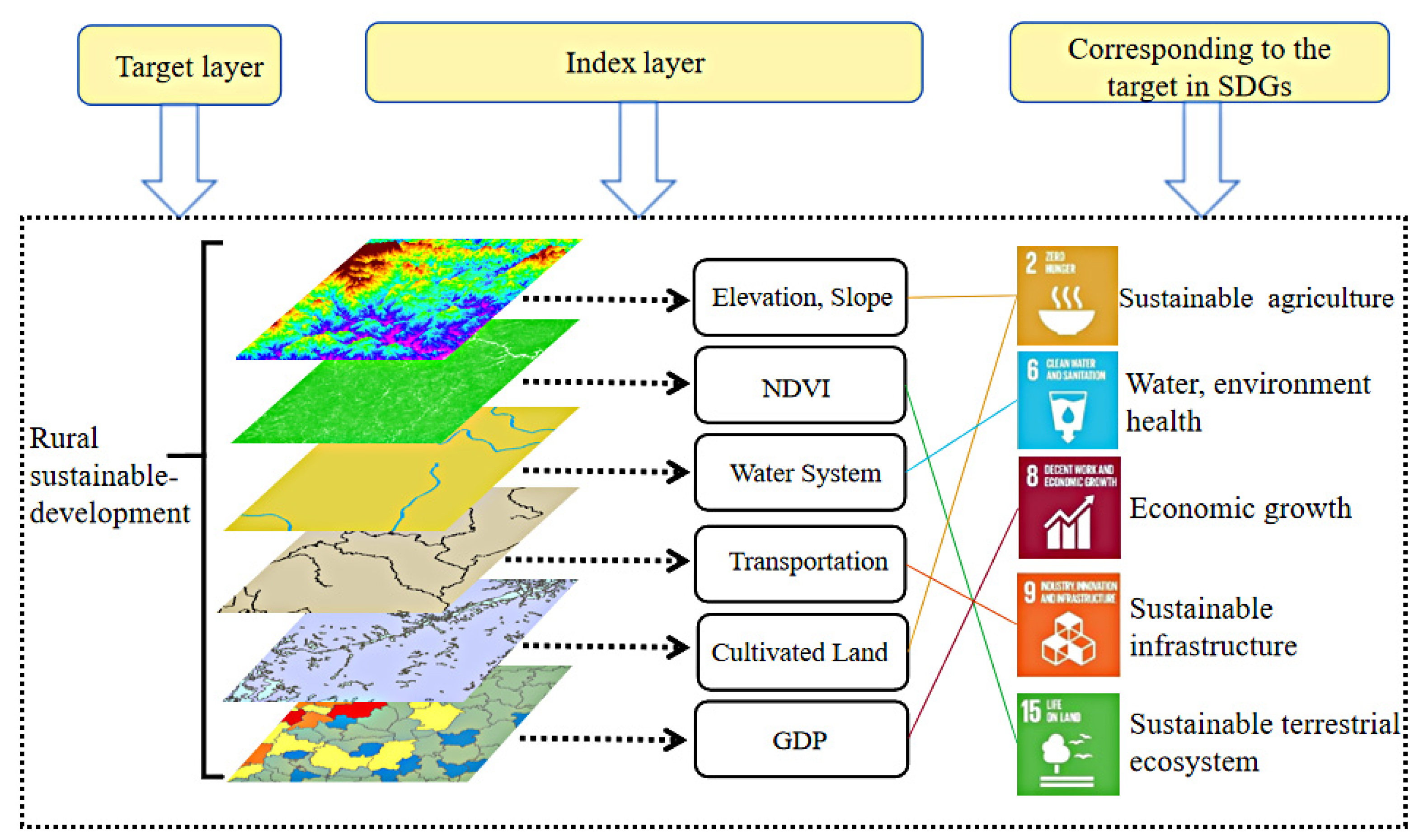
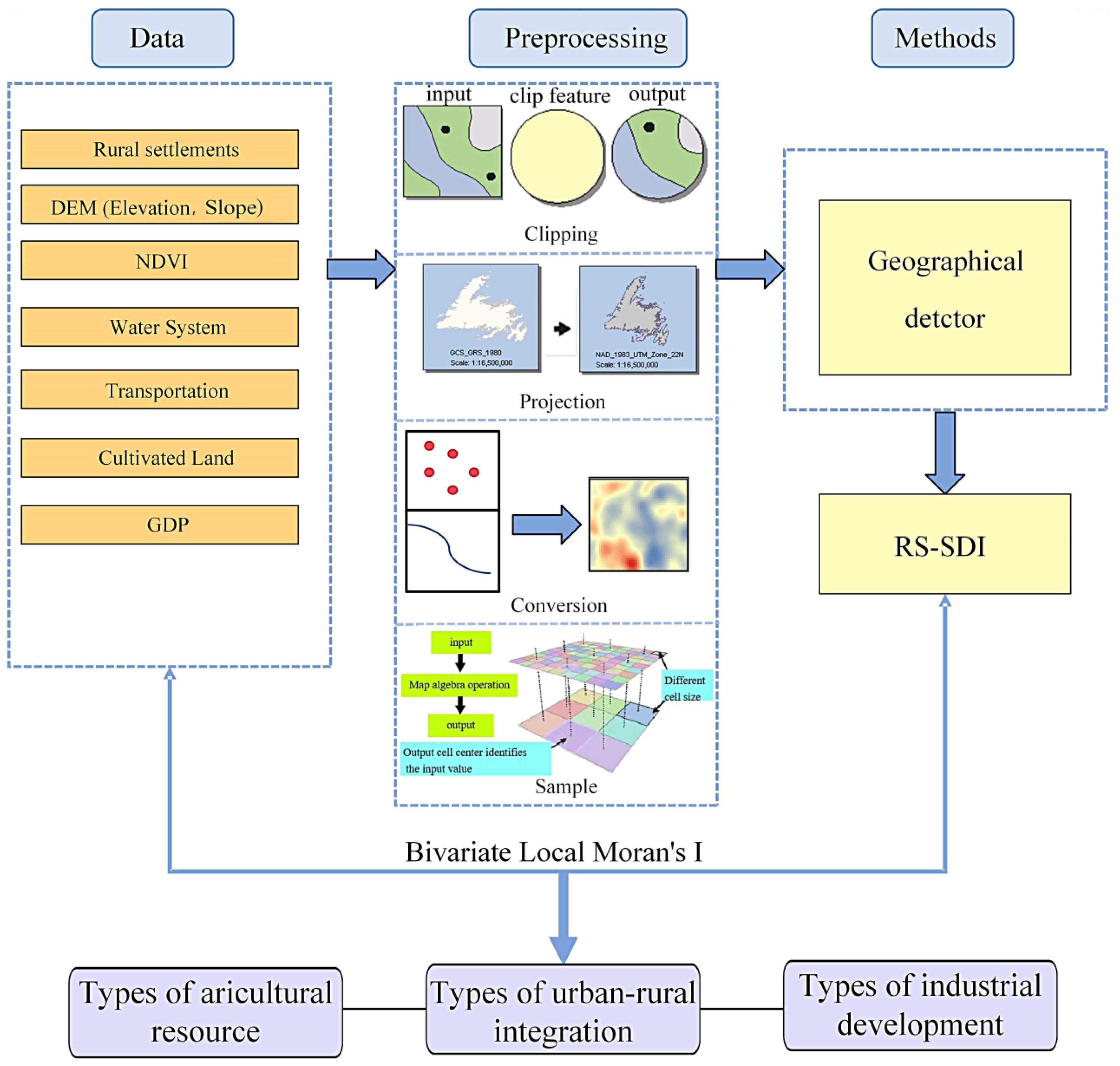
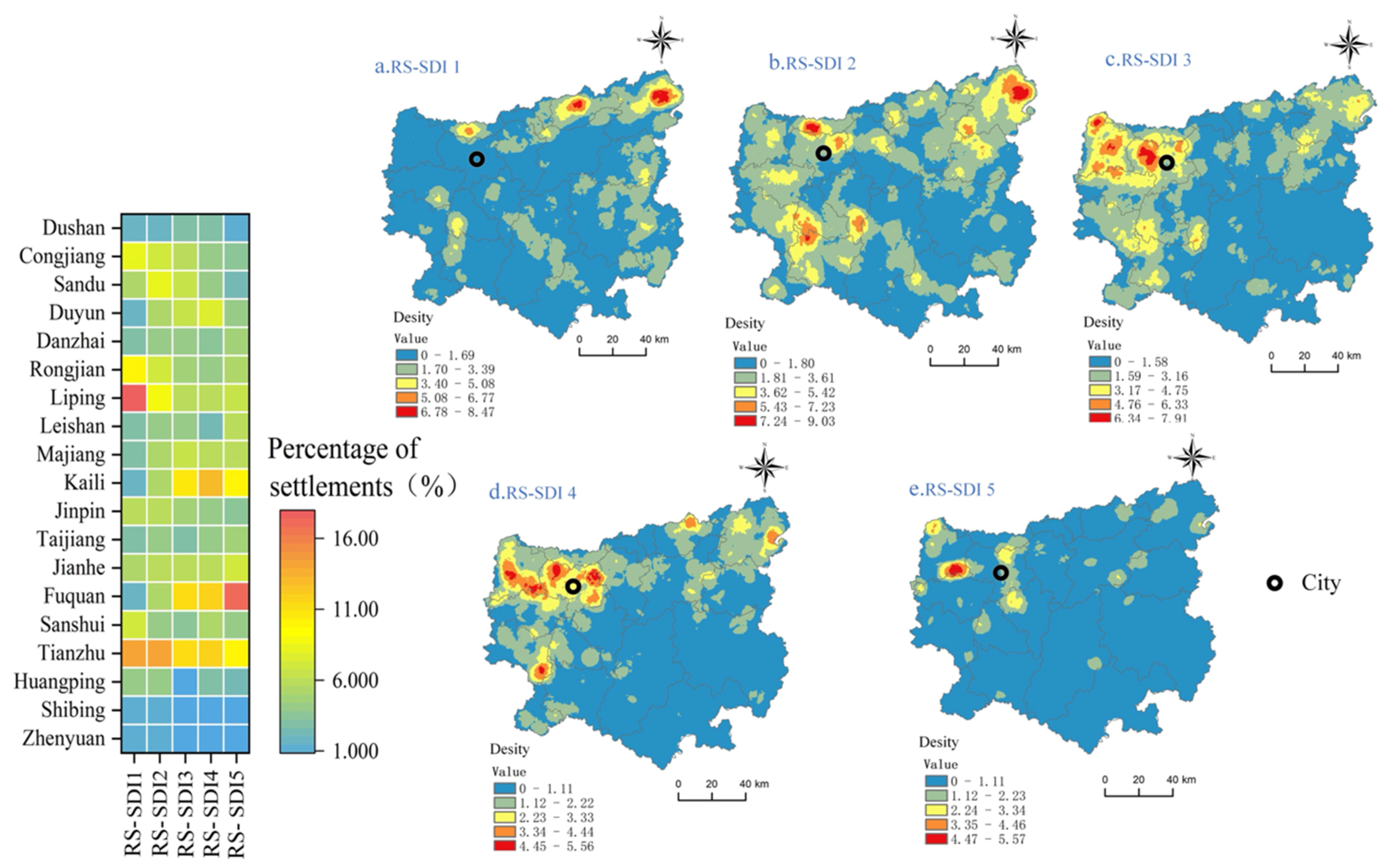
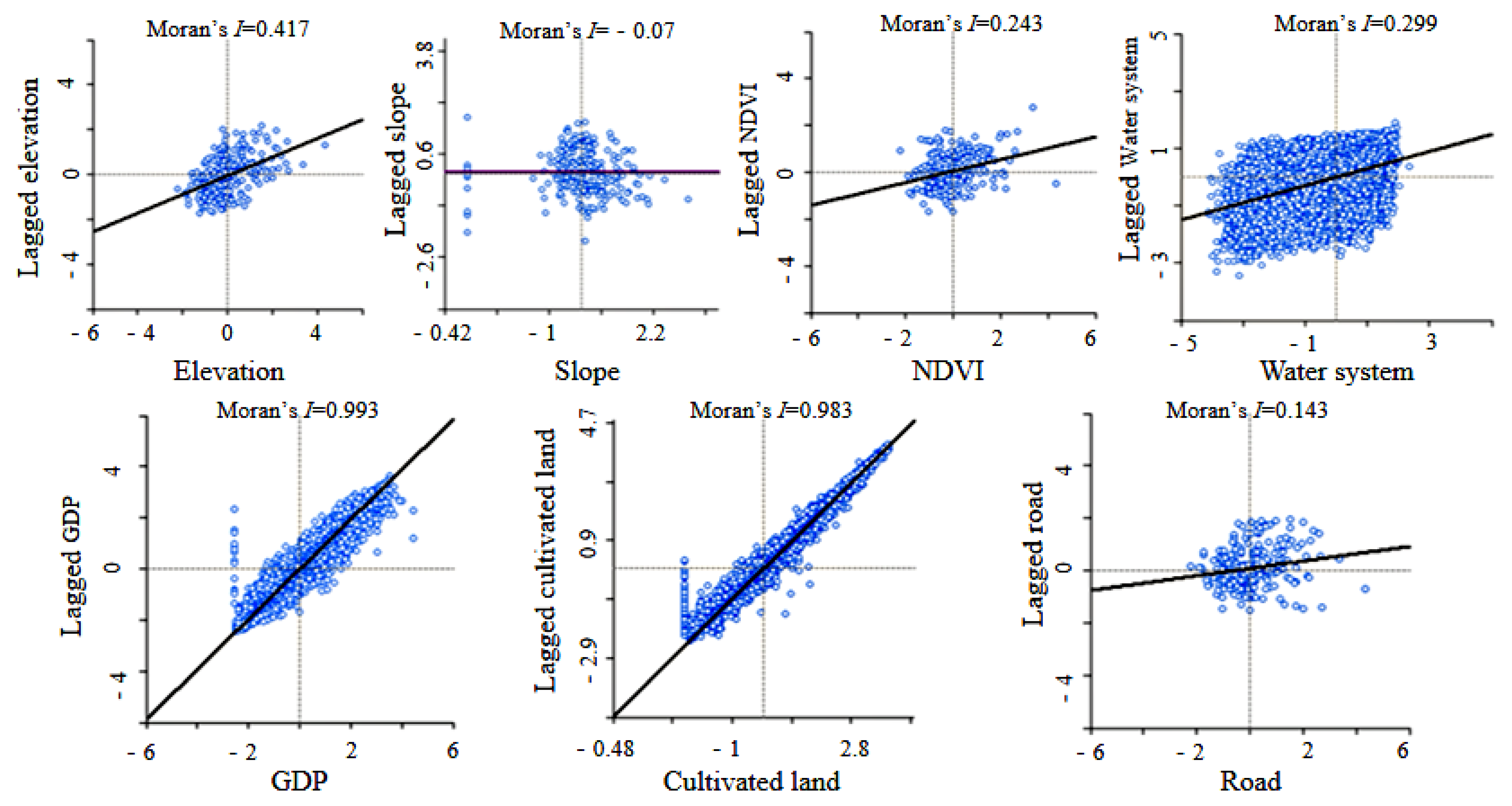
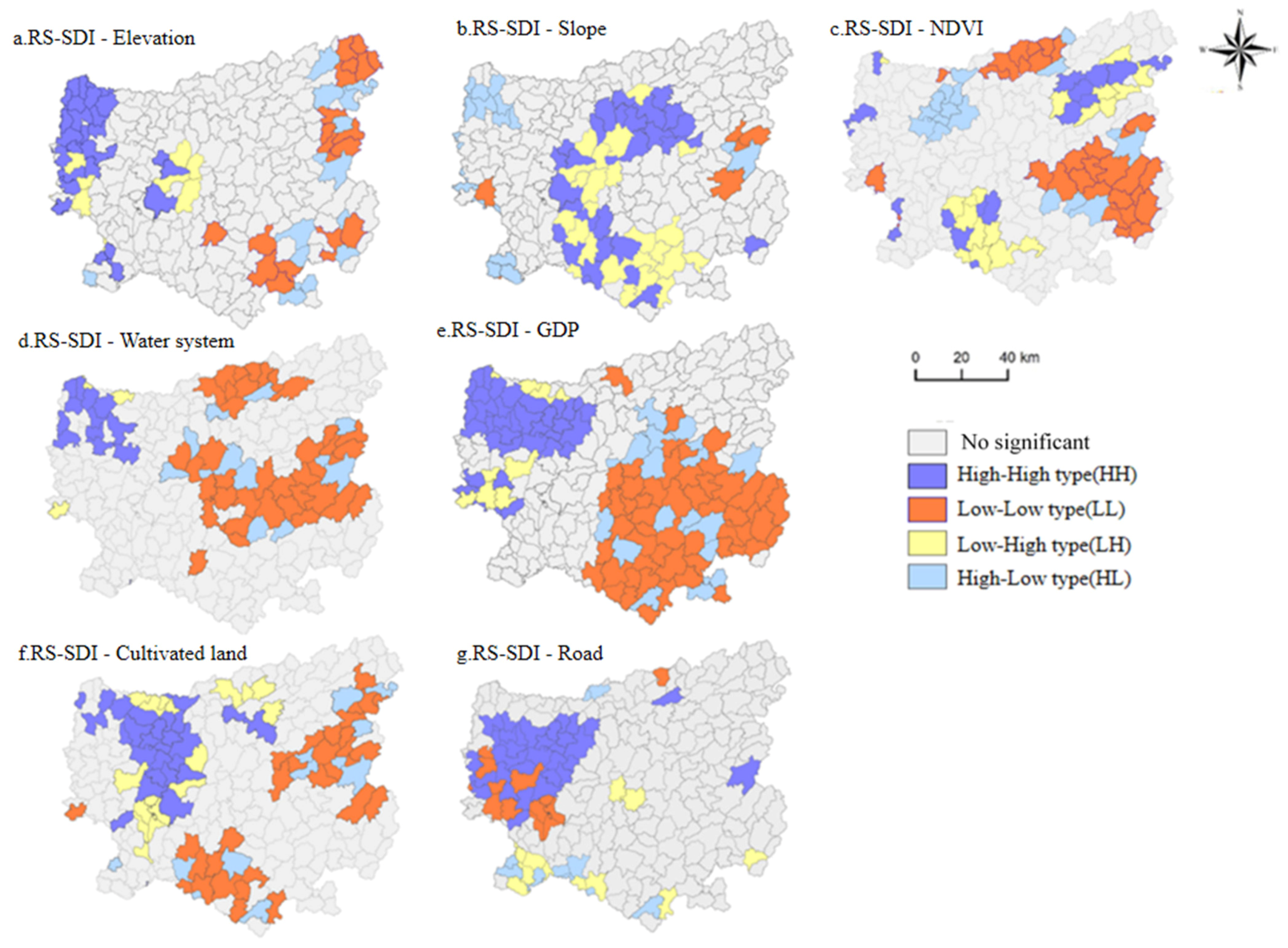

| Indicators | Basis of Selection of Indicators |
|---|---|
| Elevation | Reflects the elevation of the distribution of rural settlements |
| Slope | Reflects the steepness of the surface unit of the rural settlement distribution site |
| NDVI (Normalised Difference Vegetation Index) | Reflects the extent of surface vegetation cover |
| Water system | Reflects the accessibility of water to rural settlements |
| Road | Reflects the accessibility of rural settlements |
| Cultivated land | Reflects the primary resources and conditions of survival of the rural population |
| GDP | Reflects the social and economic development of rural settlements |
| Index | GDP | Cultivated Land | Elevation | Slope | NDVI | Water System | Road |
|---|---|---|---|---|---|---|---|
| PD,G value | 0.3919 | 0.2890 | 0.1850 | 0.0754 | 0.0355 | 0.0270 | 0.0246 |
| Weight | 0.18 | 0.17 | 0.16 | 0.14 | 0.13 | 0.12 | 0.11 |
| RS-SDI1 | RS-SDI2 | RS-SDI3 | RS-SDI4 | RS-SDI5 |
|---|---|---|---|---|
| 0.02–0.20 | 0.21–0.28 | 0.29–0.38 | 0.39–0.51 | 0.52–0.99 |
| Autocorrelation Type | HH | LL | HL | LH | No Significance | |||||
|---|---|---|---|---|---|---|---|---|---|---|
| Number of Towns | Percentage of Rural Settlements (%) | Number of Towns | Percentage of Rural Settlements (%) | Number of Towns | Percentage of Rural Settlements (%) | Number of Towns | Percentage of Rural Settlements (%) | Number of Towns | Percentage of Rural Settlements (%) | |
| Elevation | 31 | 12% | 22 | 10% | 12 | 3% | 14 | 7% | 174 | 67% |
| Slope | 30 | 11% | 7 | 2% | 25 | 9% | 18 | 7% | 173 | 71% |
| NDVI | 17 | 8% | 31 | 11% | 18 | 7% | 17 | 9% | 160 | 65% |
| Water system | 13 | 8% | 38 | 15% | 4 | 1% | 11 | 4% | 177 | 72% |
| GDP | 37 | 19% | 54 | 19% | 10 | 5% | 17 | 7% | 125 | 51% |
| cultivated land | 29 | 16% | 31 | 10% | 17 | 9% | 21 | 5% | 154 | 60% |
| Road | 33 | 18% | 12 | 3% | 13 | 7% | 11 | 2% | 174 | 70% |
| Sustainable Rural Development Models | Type of Sustainability Assessment | Typical Examples | Average Rural Sustainable Development Index |
|---|---|---|---|
| Agricultural resource-based type | Elevation HL | Wangfeng, Paidiao, Gapeng, Longquan | 0.34 |
| Slope LH | |||
| Cultivated land HH | |||
| Water system HH | |||
| GDP LL | |||
| Urban-rural integration-based type | GDP HH | Sankeshu, Yutang, Punhai, Wanchao | 0.39 |
| NDVI HL | |||
| Cultivated land HH | |||
| Slope HL | |||
| Road HH | |||
| Industrial development-based type | Elevation HH Water system HH | Machangping, Langde, Niuchang, Baimang | 0.4 |
| GDP HH | |||
| Slope HL | |||
| Road HH | |||
| Water system HH |
Publisher’s Note: MDPI stays neutral with regard to jurisdictional claims in published maps and institutional affiliations. |
© 2022 by the authors. Licensee MDPI, Basel, Switzerland. This article is an open access article distributed under the terms and conditions of the Creative Commons Attribution (CC BY) license (https://creativecommons.org/licenses/by/4.0/).
Share and Cite
Qin, Y.; Luo, G.; Li, Y.; Tan, Q.; Zheng, C.; Yu, M.; Liao, J.; Li, M. Assessment of Sustainable Development of Rural Settlements in Mountainous Areas: A Case Study of the Miaoling Mountains in Southwestern China. Land 2022, 11, 1666. https://doi.org/10.3390/land11101666
Qin Y, Luo G, Li Y, Tan Q, Zheng C, Yu M, Liao J, Li M. Assessment of Sustainable Development of Rural Settlements in Mountainous Areas: A Case Study of the Miaoling Mountains in Southwestern China. Land. 2022; 11(10):1666. https://doi.org/10.3390/land11101666
Chicago/Turabian StyleQin, Ying, Guangjie Luo, Yangbing Li, Qiu Tan, Chao Zheng, Meng Yu, Jingjing Liao, and Min Li. 2022. "Assessment of Sustainable Development of Rural Settlements in Mountainous Areas: A Case Study of the Miaoling Mountains in Southwestern China" Land 11, no. 10: 1666. https://doi.org/10.3390/land11101666
APA StyleQin, Y., Luo, G., Li, Y., Tan, Q., Zheng, C., Yu, M., Liao, J., & Li, M. (2022). Assessment of Sustainable Development of Rural Settlements in Mountainous Areas: A Case Study of the Miaoling Mountains in Southwestern China. Land, 11(10), 1666. https://doi.org/10.3390/land11101666





